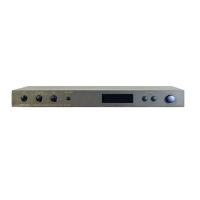This
unit
is a
Quartz-Synthesizer
FM Stereo
Tuner especially
designed
to ach¡eve
an extremely
high
level of
waveform
lidelity.
It
was developed
primarily
with the concept
of improving
the
listener's
enjoyment
of
music reproduction,
not merely
as a
component
to receive
radio broadcasts,
and
its
design
features
a
great
many
points
of improved
opêralion.
Technics tuners
are
designed with one central
concept
in mind:to
bring the atmosphere
of the concert
hall to the
home listening
room.
This high-performance
tuner ¡n-
corporates
Technics'
own original
technological advances
in order
to assure
the highest order of
waveform fidelity.
I'lg-Xttz
Pilot-signal-Cancel Circuitry
The
pilot-signal-cancel
circu¡try
used
in this unit is
spec¡al
circuitry originally
invented by
Technics' own
technology.
The 19-kHz
pilot
signal, unnecessary
for audio
repro-
duction,
is cancelled by applying
a waveform-shaped
.19-kHz
signal
to the multiplex
input, making
use of the
phase-locked-loop
lC,
thus resulting in
a flat and wide
frequency response
oÍ 2O Hz to 1B kHz
(+0.1
dB,
-0.5
dB).
I
SAW
(Surface
Acoustic Wave)
Filter Fo¡ Superb
lF
Stage
With
"Group-Delay"
Characteristic
The lF stage
includes five stages
of differential
ampli-
fication w¡th superb limiting
characteristics.
lF filtering
is achieved by using
two 4-resonator
type
ceramic
filters
plus
a special
Surface Acoustic
Wave
filter
with
independently
selectable
group-delay
and
amplification
characteristics.
The arrangement
of
these
f ilters
provides
extremely
sharp
selectivity
and an
excellent
distortion ratio. This filtering
arrangement
is connected
with adjacent wide-band,
low-distortion
FM-detection
circuitry.
I
Purely
Electronic
Front
End
Five
especially
selected
low-tolerance
variable-
capacitance
diodes
are used
in the front
end, replacing
the
conventional
S-gang variable
capacitor,
and making
the
f ront end
purely
electronic.
The design
is
particularly
resistant
to
f
requency
deviation
and external interference,
with 2 doubleluned
circuits
which use
"high
Q"
coils of
excellent
selectivity
and
¡nterference-exclusion
characteristices,
as
well
as
an RF amplifier
w¡th a 4-pole
MOSFET
and a buffer
with a
junctionlype
FET
through
which the
local
oscillator
supplies
the oscillation
frequency
to the
m¡xer.
QUARTZ
SYNTHESIZER
FOR PRECISE AND
EFFORTLESS TUNING
This
tuner employs a
"pure
electronic"
tuning system,
"locking
in" the frequency by using a
quartz
synthesizer.
The
most important leature of this synthesizer system
is
the extremely
precise
tuning accuracy which it makes
possible.
By iaking
advantage of
the
precise
oscillation frequency
of the
quartz
crystal, the
locked synthes¡zer system makes
automatic
station
selection
possible
with
a simple
fingertip
touch
of one of
the automatic-tuning
pushbuttons.
None of
the
conventional
tuner components
such as tuning knob,
flywheel,
dial scale
indication needle, tun¡ng meter, etc.
are to be
seen-and indeed
are not needed! Tuning
is
exceptionally
precise
and completely
effortless!
Recept¡on
f requencies
are
spaced at intervals of 0,2
Mf|z,
and
frequency indication
is
by clearly read and extremely
precise
d¡gital
ind¡cation.
I
Automatic
Tuning
And
New Muting System
For
Easy
Stalion
Selection
This unit takes
full advantage
of the extraordinary
features of
the synthesizer
system for automatic
station
selection.
The muting switch has
3
positions:
"fine,"
"standard"
and
"off."
.
The
"fine" position
can be used
for broadcast
re-
ception
wìth
a stereo distortion
ratio of 0.20lo
or
less.
.
The
"standard"
position
can be used
for broadcast
reception
with a stereo
distort¡on ratio
of
1
o/o
or
less'
.
The
"off"
position
can
be used
for broadcast
reception,
at 0,2
MHz
intervals, of
all broadcasts
within
the
f
requency
range of
BB.1 to 107.9
MHz.
I
High-Precision Quartz-Cryslal
Oscillation
Element
With No Secular
Variation
ln order
to obtain
its especially high
oscillation
precision,
the
quartz-crystal
oscillation element
used
in this unit
has internal
gold plating
and ¡s constructed
by using
special
cold-welding
techniques, in
a vacuum,
thus
avoiding
secular
changes and the effects
ol solder
gas.
I
ts-p¡n
"Bus
Line" Connector
For
Remote
Control Of
Internal Circuitry
This unit has a
special 16-pin
"bus-line"
terminal on
its
rear
panel
which, by using digital
technology,
makes
external
(remote)
control of tuning operations
possible.
OTHER
FEATURES
A special
die-cast
cabinet-the
type cons¡dered to
be ideal
for
communications
equipment-is
used, thus
giving
it
excellent
res¡stance
to external
impact shocks, as
well
as
providing
superb hÌghJrequency
interference
and shielding
effects,
and
high-frequency
stability.
Another
important
feature
is the
"pink-noise"
generator,
ideal
for making
recording-level
settings
and easy checks
of
the overall
audio system
There
is;
moreover,
an automatic
high-blend
function
which
automatically
operates,
by switching on
and off, to deliver
FM
music with minimized
no¡se interference.
-
l-

